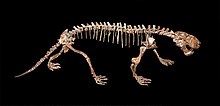Gorgonopsia
| Gorgonopsians Temporal range: Middle Permian-Late Permian, 265–252 Ma |
|
|---|---|
 |
|
| Skeleton of Sauroctonus parringtoni | |
| Scientific classification | |
| Kingdom: | Animalia |
| Phylum: | Chordata |
| Order: | Therapsida |
| Suborder: |
†Gorgonopsia Seeley, 1895 |
| Family: |
†Gorgonopsidae Lydekker, 1890 |
| Genera | |
Gorgonopsia ("Gorgon face") is an extinct suborder of theriodonts. Like other therapsids, gorgonopsians (or gorgonopsids) were at one time called "mammal-like reptiles", though "stem mammals" is more accurate.
Their mammalian specializations include differentiated (heterodont) tooth shape, a fully developed temporal fenestra, pillar-like rear legs, a vaulted palate that may have facilitated breathing while holding the prey, and incipiently developed ear bones. Gorgonopsians are a part of a group of therapsids called theriodonts, which includes mammals. They were among the largest carnivores of the late Permian. The largest known, Inostrancevia, was the size of a large bear with a 45 centimetres (18 inches) long skull, and 12 centimetres (4.7 in) long saber-like teeth (clearly an adaptation to being a carnivore). They are traditionally thought to not have had a full pelage, but some Late Permian coprolites showcasing remnants of fur may belong to them; whether they had bristles or scales is unknown. They possibly had a combination of all of them, as some mammals still do. Like most therapsids, they are assumed to have been terrestrial, and this is supported both by their morphology and bone microanatomy.
Gorgonopsians are theriodonts, a major group of therapsids that included the ancestors of mammals. They evolved in the Middle Permian, from a reptile-like therapsid that also lived in that period. The early gorgonopsians were small, being no larger than a dog. The extinction of dinocephalians (which dominated the Middle Permian world) led to gorgonopsids becoming the apex predators of the Late Permian. Some had approached the size of a rhinoceros, such as Inostrancevia, the largest gorgonopsian. A nearly complete fossil of Rubidgea has been found in South Africa. The Gorgonopsia became extinct at the end of the Permian period, being the only theriodont line to be terminated by this mass extinction.
...
Wikipedia
